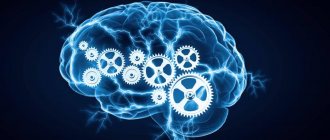How we remember information and why we forget it
From a scientific point of view, memory is the process of receiving, storing and reproducing information. When memorizing any information, our brain first receives it, then encodes it and sends it for storage in order to reproduce it at the moment when this data is needed. Notice the similarities with computers? After all, they record, store and reproduce information using exactly the same algorithm. Only machines are capable of reproducing data for sure (if the processor works correctly), but people are not. Why is this happening? Why do we forget what we learn and try desperately to remember?
Our brain is not a computer, and many of the processes occurring in it are still not 100% understood. There are a number of hypotheses that try to explain the phenomenon of “forgetfulness”. Here we are talking about forgetting what we were able to “write” into our brain, that is, remember. The most popular is the extraction theory. According to her, forgetting is not always the loss of information from memory. There are simply no incentives or effects to extract the data. Accordingly, remembering depends on clues - it can be a smell, a sound, an image and much more.
Vitamins for brain activity
Vitamins, especially group B, contribute to the development of memory, attentiveness and thinking in adults. These substances are antioxidants and can support the functioning of the central nervous system.
Vitamins to improve memory:
- B1 - responsible for the ability to quickly assimilate new material;
- B2 - capable of accelerating mental processes;
- B3 - affects the speed of memory, concentration. Necessary for those who are concerned about how to develop mindfulness;
- B5 - responsible for long-term memories;
- B6 - accelerates thought processes and increases intelligence;
- B9 - is responsible for the stability of memorization, increases performance;
- B12 - helps recode information from short-term memory to long-term memory, during sleep.
A lack of B vitamins inhibits the synthesis of amino acids, which leads to memory impairment. In addition to group B, there are other vitamins that can stimulate brain function:
- Vitamin C promotes better absorption of B-group nutrients and prevents mental overload.
- Vitamin D – protects brain cells from premature aging.
- Vitamin E – resists the harmful effects of toxins, helps to perceive new information more easily.
- Vitamin P – improves concentration and attention.
It is worth taking a blood test to determine the composition of hormones and microelements in the body. If any substances are missing, the doctor will tell you how to replenish them.
Important! Vitamins that stimulate brain activity should be used in combination.
What is human memory capable of?
- Chinese Chao Lu was able to remember all the digits of pi. This is 67,980 digits that a 24-year-old student reproduced throughout the day, without even being distracted by going to the restroom.
- Autistic artist Stephen Wiltrish was able to depict in detail on canvas the view of London, which opens from an observation deck located at an altitude of 224 meters.
And these are just two examples of the phenomenal memory of savants - this is what people are called whose memory abilities are considered fantastic. Science cannot yet explain these phenomena. Among savants there are healthy people and those who suffer from various diseases, in particular mental ones. At the same time, four-time winner of memory competitions in the United States, Nelson Dellis, speaks of the absence of any uniqueness in his personality. The man claims that he has never had a phenomenal memory and everything he has achieved is the result of regular and hard training.
Scientists from the Salk Institute for Biological Research conducted a series of experiments and created a computer model of the hippocampus, the part of the brain that is responsible for storing the information we remember. After complex calculations, they were able to establish specific values: one hippocampal neuron can store approximately 4.7 bits of information.
Our brain is capable of storing a volume of data comparable to all the information posted on the Internet. That is, in theory, we can fit the entire World Wide Web in our memory.
Expanding your memorization capabilities
You cannot train your memory in one lesson, even if it is part of the most popular and expensive course taught by a certified psychologist.
We offer effective ways to develop your thinking processes at home and completely free of charge.
Feelings
The method of co-feelings allows you to build memorable associations. To do this, you need to learn to connect all five senses. For example, create associations for the word “airplane.” How do you see it? What do you hear? How do you feel after the touch? What taste do you feel? What's the smell?
In this way, you can learn to more acutely perceive and remember new data more reliably. It is difficult to forget something that caused the activity of several senses at once.
Training attention
Attention is something without which it is impossible to achieve maximum memory. In the era of information overload, it is simply necessary to be able to focus on what is important. The following exercise is suitable for those who are looking for how to train memory and attention for one minute a day.
Set your stopwatch to 60 seconds. Make marks in the figures as shown in the example, strictly one by one. Repeat the exercise every day until you can cross out everything correctly and meet the deadline. If you wish, you can increase the difficulty level and increase the number of figures. Print as many copies as you like and make the actions automatic.
Memorizing texts using pictograms
Pictograms surround us everywhere. These include smartphone icons, road signs, and brand logos. Pictograms are an excellent means of memorizing any text that needs to be stored in memory verbatim, no matter if it is a verse, a quote or a definition of a term.
A clear example of the use of this technique is in the book “100% Memory” by E. Dodonova.
So, in the first picture we see an excerpt from E. Yevtushenko’s poem “The Third Snow”.
This is how the author of the book depicted these lines using pictograms.
Thus, every person, young and old, can learn to quickly memorize by drawing pictograms as their own imagination dictates.
Even those who don’t know how to draw can draw pictograms, because you just need to draw a schematic icon for each word.
How to develop memory for an adult
First of all, determine the goal: you must understand why you want to develop memory. A specific goal determines the motivation that is necessary for effective memorization and at the same time serves as an incentive for its further reproduction. For example, you want to improve your memory to improve the quality of your exam answers or stop forgetting to buy everything you need at the store. These are examples of specific goals that you need.
Next you can use:
- Exercises for memory development.
- Mobile applications.
- Complex techniques.
- Patterns of behavior.
Don't miss: Which foreign language to study: TOP 5 most promising
Science does not yet provide precise answers and does not explain how to quickly develop memory. We can only be guided by human experience and talk about techniques, exercises, models and programs that have helped improve memory for millions of people. However, there can be no guarantees in this case: much will depend on the individual characteristics of your memory, your lifestyle and the type of information you remember. In any case, we can talk about the effectiveness of each specific exercise only after “testing” it for 1-2 months.
Cognitive ability test
Friends, if you want to learn much more about yourself, I advise you to take an important test.
The Cognitive Abilities Test from Vikium is a diagnostic program for assessing the functioning of cognitive functions (attention, memory, thinking) and compiling a psychological profile of an individual.
What you will get as a result of the test:
- Personal profile card with assessments of cognitive abilities and personality characteristics.
- You will learn your strengths and weaknesses in various cognitive areas, as well as personality traits.
- You will understand what is associated with your productivity in certain types of activities and what needs to be done to improve it.
Testing includes complex diagnostics (cognitive profile):
- concentration and switching of attention;
- verbal and non-verbal logic;
- visual-figurative thinking;
- verbal-logical memory;
- short-term and long-term memory.
You will determine (personal profile):
- type of thinking and level of creativity;
- leading style of activity;
- ability for self-regulation;
- personality type with all its features.
Suitable for a wide range of users: teenagers over 14 years old, adults and the elderly.
You don’t need any special knowledge to pass; the test takes place in a playful and test form.
Duration: 30–40 min.
Cost: 990 rub.
Who Vikium is and why they are great, you can read in our special review.
The most effective techniques
- Household . This technique involves some changes in lifestyle. It is proposed to give up shopping lists and notebooks - you need to try to remember and try to remember everything that is necessary. Shopping list, phone numbers, friends' birthdays, etc.
- Learning foreign languages . According to psychologists, learning a language simultaneously develops memory, quickly and intensively. Some experts even recommend learning 2 languages at the same time. But they are silent about the effectiveness of such training.
- Books and Poems . Read more books - when reading, the brain always concentrates on details and memorization. Memorizing poems and song lyrics is no less effective. Ideally, they will be in a foreign language.
- Do not give up . Do not rush to open the phone book if you have forgotten your phone number. Try your best to remember it, and then check the exact information. Do this all the time.
- Count . Solve the most difficult arithmetic problems you can in your head. Add up the numbers on the license plates of cars that you meet in traffic (but only if you are not a driver). Count the number of birds in a flying flock. The more you count, the better for your memory.
Classification of types of memory
Memory is classified according to different criteria. Let's look at the main ones.
By duration
This is a criterion that determines how long information is retained in the brain. The following types of memory are distinguished:
- Operational . This is a superficial and short-lived memory. It is also called a worker. At this level of memorization, the storage period of information is limited to the period of its use. For example, to understand what a sentence is about, you remember the meaning of the words written in it. Having read the sentence to the end, you will no longer be able to reproduce it verbatim, but convey it in your own words. Just as we ourselves understood. The most interesting thing is that the brain does not even strive to remember this information. However, RAM capacity can be increased through training.
- Sensory . The first step in the process of memorizing information. It belongs to the physiological level, since it remembers signals coming from the senses. Information is stored for no longer than 4 seconds. The most famous types of sensory memory are auditory and visual. Only a small part of the information received through hearing or vision attracts our attention. But when this happens, it already moves from the stage of sensory memory to the level of short-term memory.
- Short-term . The stage of memorization at which the conscious process of information processing begins. At this level, the information that interests us is stored for no longer than 30 seconds. During this time, the brain processes the received data and determines the degree of its importance. Important information is duplicated, and unnecessary information is deleted. Short-term memory can hold no more than seven unrelated elements. To remember such information for a long time, you need to focus on it and repeat it several times. Otherwise it will be replaced by other data.
- Long-term . This type of memory is characterized by a huge volume and almost unlimited storage life. For information to reach this stage, it must be comprehended, analyzed in detail and made associations with existing information. Mere memorization will not help here. But even if you remember the information correctly, it can be difficult to retrieve from long-term memory because it is rarely used.
According to mental processes
Information enters the brain through various channels. Depending on this, the following types of memory are distinguished:
- Figurative . The largest amount of information is stored in us in the form of images received through the senses. Here we distinguish between visual, auditory, tactile, olfactory and taste memory. This type of memory is the first that begins to work in newborns. There are also cases of memorizing information with phenomenal accuracy, down to the smallest details. This type of memory is called photographic memory.
- Motor . It is one of the most ancient ways of remembering information that arose in the process of evolution. Motor memory plays a very important role, and not only in sports. Without it, a child will not be able to learn to walk, run, jump, or draw, and an adult will not even be able to pour himself some tea.
- Emotional . This type of memory is activated when we experience strong feelings and vivid emotions. First love, the birth of a child, the bitterness of resentment, the joy of meeting after a long separation with loved ones, etc. Such information is always associative in nature. Therefore, it is enough for some small detail to appear for us to again plunge into this waterfall of long-experienced emotions. True, they will never achieve that original strength.
- Verbal-logical . This is the youngest type of memory. It is unique to humans because it is conscious in nature. We remember information not as a set of sounds or symbols, but as a meaningful fragment. It is this type of memory that requires targeted training to improve.
Exercises developing memory and attention
How to develop memory and attention in an adult with the help of exercises? Do them regularly. It is also important to choose exercises that you like and do not cause intuitive rejection. If you try to improve your memory while suffering and being stressed at the same time, the exercises will drive you crazy and nothing will come of it. We have selected for you some of the most effective exercises, according to experts.
Schulte tables
They help not only improve memory, but also master speed reading. The most widely used is the Schulte table, which represents a square with 25 cells, in which numbers from 1 to 25 are placed in a chaotic order. It is necessary to silently count to find all the numbers in order as quickly as possible. For each workout you need to use a new table with a different arrangement of numbers.
Aivazovsky method
It is difficult to imagine how Aivazovsky managed to mentally stop the movement of the wave and transfer it to the picture. Your task will initially be simpler: look at the object for a few moments, then close your eyes and try to imagine it in all details. Gradually complicate the task: if first you decide to memorize an electric kettle, then after several trainings try to reproduce in your memory the complex bas-reliefs of the building that you saw with your own eyes or in a photograph.
Film reel
The essence of this exercise is to try every day to remember everything that happened to you during the day. Ensure silence, divide the day into time periods (at first by hours, then every 10-15 minutes). Don't skip sections at once - make every effort to remember every phone call and every tea party.
Game of differences
Remember children's educational games, during which the child is asked to find the differences in two pictures? It turns out that they are most effective for the development of memory and attention. Moreover, a lot of such exercises are aimed at adults - it is incredibly difficult to find differences here. You can easily find them online on specialized resources and even in mobile applications.
Memorizing blocks of information
Not only an exercise, but also a frequent necessity. These are cases when we need to remember a block of information, for example, while preparing for an exam. It is important to use mechanical memory here. Accordingly, it is recommended to depict words and phrases and show them with gestures. In this case, the information must be spoken or rewritten. It is important that during memorization you change the environment - for example, move from room to room, from one classroom to another, and so on.
Laws of memory
The development of any type of memory in adults is a process that depends not only on the time spent learning effective techniques, but also on an understanding of the laws of memory. These are reference points that will help you not get lost in the maze of mental activity.
- It is impossible to remember something unclear.
In order for information to be stored in the brain for a long time, it must be realized. A person is able to remember words whose meaning he knows.
- Associative thinking is a memory aid.
Associative perception is based on the fact that a new image recalls from memory an already existing one in consciousness. Associations can be based on contiguity (winter and snow), contrast (white and black) and other indicators, but for better memorization, sometimes it is necessary to turn off logical thinking in favor of imagination. Associations remain in memory:
- bright, unusual, even absurd;
- emotional (funny, sad, amazing);
- created using all senses;
- are in motion.
- Deceive the magic seven.
Psychologist Miller proved that short-term memory can hold 7 plus/minus 2 units of data. How to train your memory to improve this indicator at least twice? It's simple. Skip the unnecessary stuff and group the necessary information.
- Tune in.
Don't say, "I have a lousy memory." Say: “I will definitely remember this.”
- Repeat correctly.
The development of memory and attention in adults is impossible without the ability to correctly repeat what has been learned. An effective algorithm for remembering forever is:
- repeat information immediately after learning;
- then after 15-20 minutes;
- before bedtime after 6-8 hours;
- the next day;
- a week later;
- a month later.
How to develop your brain and memory by changing your lifestyle
Scientists are convinced: our ability to remember, store and reproduce information largely depends on our physical and mental state.
Your brain must be on alert and have all the necessary resources to work effectively. And in order to develop phenomenal memory, it is often necessary to change your lifestyle. Here's what you need to do first:
- Eat properly. Get enough proteins and complex carbohydrates - include cereals, nuts, vegetables and fruits in your diet.
- Get enough sleep. Don't limit your sleep to hours - sleep as much as your body needs. If you want to sleep an hour after you get up, you haven't gotten enough sleep.
- Get rid of stress. It’s often worth changing a job you don’t like, stopping communicating with people who irritate you, and getting out of conflicts. In short, do everything possible to avoid exposing yourself to stress.
How to develop the memory of a person who is constantly under stress, on a coffee diet, restricts himself in carbohydrates and chronically does not get enough sleep? No way. Your brain needs to rest and find resources to work. These resources are nutrients and vitamins. Eat right, don’t deplete your body with diets taken from the Internet, and get enough sleep regularly. Only then will the exercises be as effective as possible.
Folk remedies to improve memory
Improvements in brain activity can be achieved not only through training. You can use folk remedies to lower intracranial pressure, get rid of tinnitus, and reduce migraine symptoms, thereby improving your memory.
For example, you can make clover tincture . To do this, fill a 1-liter container with the heads of this plant and fill it with vodka to the top. The tincture should be stored for 2 weeks in a cool place, protected from light.
You need to use 1 tbsp. spoon at night for three weeks.
Important! This method is contraindicated for expectant mothers and people with heart failure.
You can increase brain activity using elecampane root tincture . The crushed roots of the plant (1 tablespoon) must be poured into a container and added 2 glasses of vodka, then put in a dark place. After a month, the infusion is filtered.
You need to take the product three times a day before meals in an amount of 20 ml. Treatment should be carried out at least 30 days a year. Contraindicated for people with heart and kidney diseases, as well as during pregnancy.
Red rowan bark will help stimulate brain function . One tbsp. A spoonful of rowan is poured into a glass of hot water and boiled on the stove for 10 minutes. The decoction should steep for 5-6 hours, after which the mixture is filtered. 20 ml of decoction should be taken 3 times a day. The course should be 35 days, twice a year. You should not take the infusion if you have increased blood clotting or pregnancy.
The best advice from doctors and coaches
Exercise regularly
Practice shows that only systematic training brings results. This is evidenced not only by research, but also by the experience of winners of memory championships in different countries. All of them noted the average quality of their memory until they began to train regularly.
Do what you like
If an exercise annoys you, don't do it. Find techniques that won't stress you out. There are hundreds of options online, and dozens of applications have been developed for smartphones. Find exercises that you enjoy. It is important that you enjoy doing it.
Develop attention and logical thinking
This is as important as reading and learning poetry. Logical thinking is built on step-by-step perception. Open a textbook on logic - it will greatly help you not only direct your thinking in the right direction, but also improve your memory, attention, and concentration.
Exercise and walk more often
For good memory, the quality of cerebral circulation is extremely important. It, in turn, directly depends on oxygen. Therefore, it is recommended to do as much aerobic exercise as possible (running, squats) and walk more often.
Set goals
It is important to understand why exactly you are training your memory. Set clear goals, identify problems that you can solve. Motivation is very important not only for the regularity of training, but also for its effectiveness.
Memory training in older people
In old age, brain function noticeably weakens. This is due to the fact that the ability of nerve cells to respond to external and internal stimuli decreases, as a result of which brain activity decreases. In addition to deterioration in memory, there is also a loss of concentration. But this does not mean that these processes are a consequence of the disease, or that the situation cannot be improved. Let's look at ways to train memory in older people:
- Collect puzzles. Choose the picture you like and go ahead! Just don't start with large and complex ones, because they may be difficult to assemble, and you will get tired of such an activity.
- Before you go to bed, sort through the events of your day: remember the things you did, who you met, what you talked about. The more detail you remember, the better.
- Come up with 5-10 words for each letter of the alphabet. This exercise will take time, but at the end of it you will feel the active work of your brain!
- Play board games - chess or checkers. Pay special attention to concentration when coming up with moves. Solve crosswords, scanwords. By playing for 30 minutes every day, you will activate your attention and memory process.
What kind of shower is called circular?
Therapeutic and preventive effects on the body can be achieved by taking a circular shower. This is not only a pleasant, but also a useful hydro procedure, common in therapeutic medical institutions, SPA salons and resort sanatoriums.
Circular shower
The method of treatment and prevention through this type of therapy has long been well studied. Irritation of skin receptors resulting from exposure to numerous thin jets of water has a positive effect on the tone of the body as a whole, and also has a beneficial effect on performance and mood.
Based on the sensations that such a water procedure causes, a circular shower is also called a “needle” shower. The impact of many thin streams of water on the body is similar in sensations to acupuncture over the entire skin surface.
In German medicine, this hydroprocedure was called “Mantel-shower” (covering shower), from the German word “Mantel”, which translated into Russian means coat or cloak. At its core, the water from a circular shower envelops the body from all sides, which can truly be associated with covering a coat.
Nutrition
To quickly reduce cholesterol you need to follow certain dietary rules. You will need to completely eliminate foods that produce bad cholesterol. You can quickly reduce cholesterol with folk remedies.
You need to add foods to your diet that contain special monounsaturated fats, healthy pectin, essential fiber and important omega-polyunsaturated fats. Using these products, you can maintain optimal cholesterol, reduce it, or remove “bad” cholesterol.
Among the basic nutritional rules, important factors can be identified:
There are a lot of useful things in fish - tuna, mackerel. To quickly reduce the total level of bad cholesterol, simply eat 100 grams of fish a couple of times every seven days. This is an ideal opportunity to maintain all blood in a predominantly liquefied form, meaning the risk of blood clots can be effectively reduced. It is worth eating a small amount of nuts. This is a fairly fatty product, which contains a lot of healthy monounsaturated fats. Experts recommend eating 30 grams of nuts every day. These can be walnuts, Siberian pine, forest, Brazilian, almonds, pistachios and cashews. It is quite possible to increase cholesterol levels through the simultaneous consumption of sunflower seeds, healthy flax seeds, and sesame seeds. To understand the approximate amount of nuts consumed, it is worth knowing that 30 grams is 7 walnuts, 22 almonds, 18 cashews or 47 pistachios. It is worth adding unusual vegetable oils to your diet, but giving preference to flaxseed and soybean oils. The most beneficial is olive oil. It is better to add it fresh to food and salads. It is recommended to eat soy products and healthy olives, only the main thing is that there is an inscription on the package stating that there are no GMOs. To reduce the substance, you should eat 35 grams of fresh fiber every day. This is a special substance that is present in large quantities in cereals, legumes, bran, greens, vegetables and various fruits. Bran should be consumed in 2 tablespoons and be sure to wash it all down with water. There is no need to neglect apples and other fruits. They contain healthy pectin, which allows you to remove excess cholesterol or reduce it. A large amount of pectin is found in products such as watermelon, citrus fruits, beets, sunflowers. Pectin is a very useful substance that helps eliminate toxins that lead to heavy metal disease, which is quite important in the relatively unfavorable environmental conditions of modern cities. To remove excess cholesterol from the blood or reduce it, you need to carry out juice therapy from time to time. It is useful to drink juice from various citrus fruits - orange, grapefruit. If you are preparing pineapple, pomegranate, apple or other juice, you can add a little fresh lemon juice to them. It is worth consuming various berry juices, as well as vegetable juices, especially from carrots and garden beets.
Any juices should be consumed with caution, especially if you have liver problems. You need to start with the minimum dose and gradually increase it. Fresh green tea is most beneficial for high cholesterol
With its help, you can not only reduce bad cholesterol for the body, but increase the amount of good cholesterol. Tea can be replaced with mineral water from time to time.
There are also certain general rules for eating with high cholesterol. Many experts note that almost every person in the body has a gene that increases the amount of good cholesterol.
To activate it, you just need to eat right and eat food every 4 hours and preferably at the same time. Then lowering cholesterol with folk remedies may not be necessary.
Many people think that in order to reduce the amount of dangerous cholesterol, you need to give up eggs and butter, and supposedly you shouldn’t eat lard.
Scientists have concluded, this is an erroneous opinion, that the synthesis of the substance in the liver is inversely dependent on the volume penetrated with products. In other words, synthesis will increase if there is little substance in the blood and can be reduced if there is a lot of it.
Important! If you completely stop eating foods that contain cholesterol, it will immediately begin to be produced by nature in decent amounts.
Butter and eggs contain healthy cholesterol, so you shouldn’t stop eating them. A ban should be placed on products containing refractory fats from beef or lamb.
It is worth reducing the amount of cream, full-fat milk, homemade sour cream, and saturated fat cheese consumed
It is important to remember that cholesterol is found in large quantities in fatty foods of common animal origin.
Accordingly, if you need to reduce the amount of cholesterol, you should exclude these foods. If you eat poultry meat, you must remove the skin from it; this is where the fat is located and its amount can be reduced.











